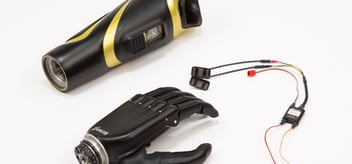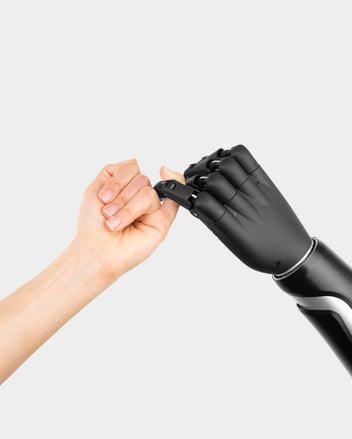Types of Upper Extremity Prosthetic Hands
The process of being fit for your prosthesis can be a long one, but it is well worth it in the end when patients find a prosthetic hand that meets their needs. Still, with so many options available on the market, many patients have trouble choosing the right prosthesis. For this reason, we have consolidated the most common types of upper extremity prosthetic hands, in addition to our own product, to help patients better understand their options and find the best prosthesis for their needs
Components of an Upper Extremity Prosthetic Arm
Before fulfilling the prosthetic prescription for any upper limb amputee, the prosthetist must carefully assess and examine the patient’s residual limb condition with respect to different anatomical and physiological characteristics, as well as various other sensory and motor examinations. Following the assessment, the prosthetist will discuss the wide range of available options and types of prosthetic componentry with the patient and rehabilitation team and then decide the most appropriate prescription for their needs.
The different prosthetic components used in a prosthetic arm generally include a socket to anchor the prostheses on the limb, which uses a suspension system to hold the prosthesis on the body, and a terminal device (hand or hook). The terminal device will perform the activities, along with different prosthetic joints such as wrists, elbows, and shoulders that provide different movements to the user depending on the level of limb absence.
Upper extremity prostheses differ in their functioning and control mechanisms. Depending on the patient's needs, a prosthetist may prescribe an active or passive prosthetic hand. Similarly, any user has the choice to either use their own body power to control the prosthetic hand or to use external sources of power to control the prosthetic hand. Between passive and active prostheses, there are a few options that patients have to choose from, which we will dive into now.
1. Passive Prosthetic Hand
As the name suggests, a passive prosthetic hand doesn’t have the joints that operate via control strategy as other prostheses do. A passive prosthesis mimics the anatomical structure of the hand, hand, and fingers, and is prescribed for cosmetic reasons. Their focus lies more on the aesthetic appearance of the body rather than the functionality. These prosthetic hands provide amputees with a lightweight solution for the stabilization of objects while maintaining a normal body image.
Passive prostheses are available as either static devices or adjustable devices. Static prosthetic hands are stationary and do not move at all. In contrast, adjustable prosthetic hands consist of an adjustable grasping or locking mechanism that can be adjusted to lock the elbow if required to mold fingers. While this may be a satisfactory option for many patients with upper limb loss, it is not the most feasible for those desiring a high level of functionality.
2. Body-Powered Prosthetic Hands
The next step from a passive prosthetic hand would be a body-powered prosthetic hand. In body-powered prosthetic hands, the prosthetic components are controlled by the user’s own body movements and forces. The force that is required to control and move the components is mechanically transmitted from the user’s own remaining muscles through a harness and cable system anchored to the prosthesis. For high-level amputees (such as shoulder disarticulations) where a significant portion of the limb is missing, this required muscle force is transmitted from the opposite side.
Body-powered prostheses provide good tactile feedback to the user about the surrounding environment and often function as an extended limb. These prostheses are simpler to use, more durable, require less maintenance, and are often more cost-effective than alternative hands. However, the appropriate force and strength needed to comfortably operate the prosthetic hand depend on a number of patient factors, including strength, posture, and other available motion in the anatomical joints. The major drawback of using a body-powered prosthesis is that it is cumbersome as it requires a harness and cable system to be worn for operation.
3. Externally Powered Prosthetic Hands
Externally powered prosthetic hands make use of external sources of power to control and move the prosthetic joints. These prosthetic systems provide active movements for the patient without utilizing the gross motor movements. Externally powered prostheses often use sensors and other means of input to pick up electric signals from the remaining muscles. These systems consist of batteries, electrodes, motors, switches, and many other electronic components that complete the prosthetic pathway. The bioelectric signals are then amplified, processed, and changed in a manner that can be then used to control the prosthetic hand.
Since these prosthetic hands are powered by external sources, their grasping strength is often greater than that of body-powered components. Externally powered prostheses usually do not require any additional straps and encompassing cable systems to hold the prosthesis in place, therefore they are less restrictive and allow more freedom of movement to the users. Moreover, the system can be actively operated with limited force and strength.
4. Activity Specific Prosthetic Hands
Activity-specific prosthetic hands are specifically designed prostheses that are used by amputees for different recreational or vocational activities, such as gardening, playing sports, fishing, heavy manual labor, or swimming. Such prostheses are generally prescribed to amputees who want to perform a specific activity but are at risk of residual limb damage due to that activity or those whose prostheses are not suitable for performing that particular activity.
Hybrid prostheses consist of a specially designed socket interface and a terminal device that is most suitable to perform the desired activity. An example of this would be a terminal device that has the option of attaching gardening tools or one that allows the amputee to use a fishing line. Hybrid prostheses can be passive or active, depending on the user's needs.
The type of prosthetic system that is most suitable for any particular patient always depends on a large number of different factors and must always be decided after a thorough assessment and consensus between the user, the prosthetist, and other members of the rehabilitation team.
5. Multi-Articulating Myoelectric Hands
A multi-articulating, otherwise known as a bionic hand, can be an excellent option for individuals seeking a higher level of functionality than the externally-powered hand. Bionic hands are controlled by an individual’s muscles to move seamlessly, in addition to the hand’s own battery system to support these movements. This is in contrast to a passive prosthesis which requires complete body power to move.
As this hand is supported by technology, it provides users with greater strength, control, and agility, serving as a functional limb. Users can modify the hand for adjusted grip, allowing them to better complete daily activities and tasks. Furthermore, a bionic hand can offer users more dexterity and strength than alternatives, giving them the power they need to complete a wide range of activities and tasks. Such a hand falls under the category of our own product, the Zeus.
Choosing the Right Prosthesis
As a patient, choosing the right prosthetic hand is a critical decision. It can be challenging to choose the right one with so many options available, particularly for users looking to participate in unique activities. Fortunately, developments in prostheses have made it possible for users to pick a hand based upon their lifestyle and needs - no matter the activity.
Our product, the Zeus, is a high functioning, multi-articulating bionic hand. We designed the Zeus with the goal of meeting all of a user’s needs, ensuring that no matter their lifestyle or the activities they perform - our hand can support them.
If you’re interested in learning more about the Zeus, visit our website.










